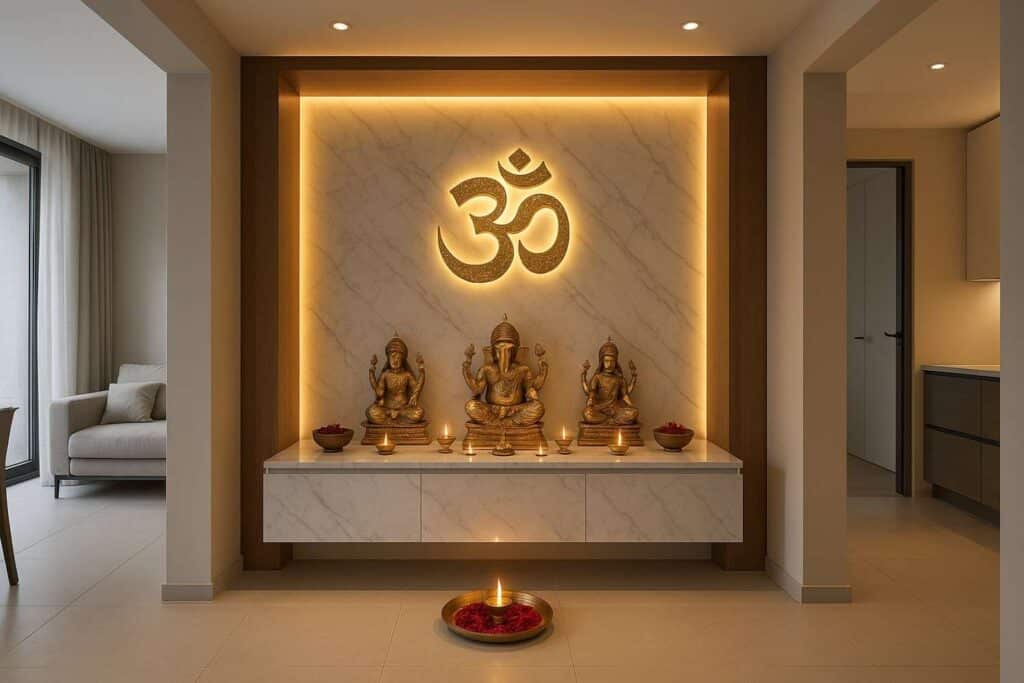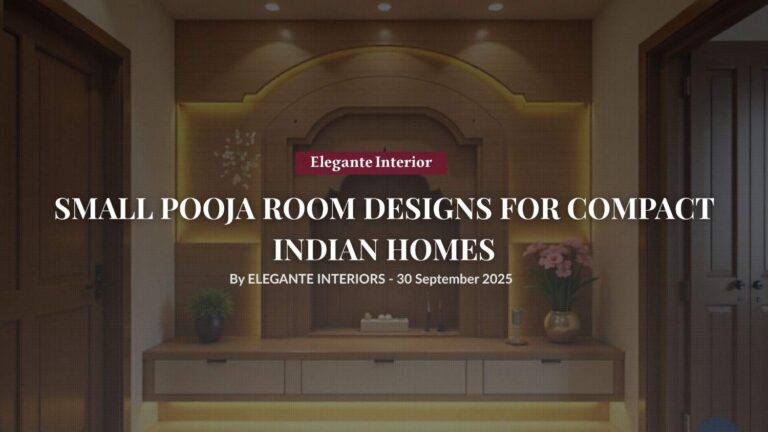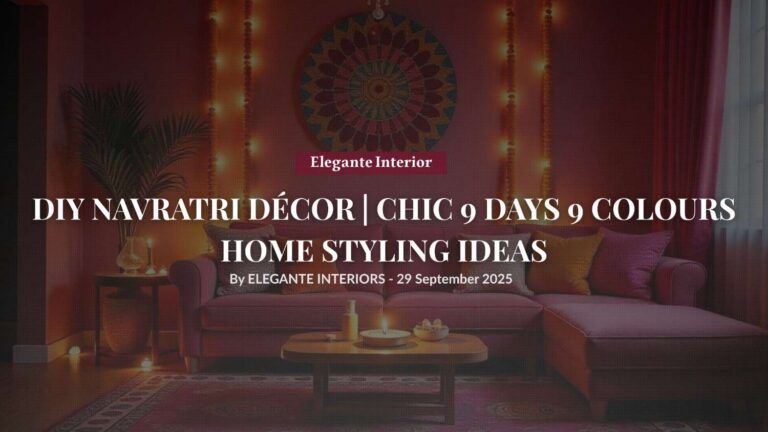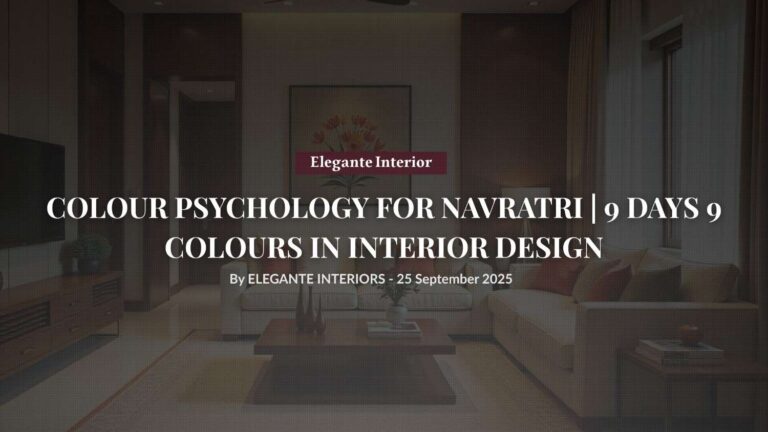By the Design Team at Elegante Interiors | 14 Years Combined Experience | Last Updated: June 2025
In today’s rapidly evolving interior design landscape, the sacred pooja room has undergone a remarkable transformation. We’re witnessing homeowners break away from traditional wooden cabinets tucked into corners, embracing designs that seamlessly blend spirituality with contemporary aesthetics.
Why Modern Pooja Rooms Are Revolutionizing Sacred Spaces
We’ve been designing pooja rooms for over a decade, and honestly, the transformation we’ve witnessed is remarkable. Gone are the days when spiritual spaces were afterthoughts squeezed into whatever corner was available.
Modern pooja room ideas aren’t just about aesthetics—they’re about creating spaces that genuinely enhance your spiritual practice. We’ve learned that when families have beautifully designed prayer areas, they actually spend more time in meditation and worship.
In our experience, contemporary pooja rooms solve three major challenges urban families face: limited space, integration with modern home decor, and maintenance difficulties. We’ve designed over 500 pooja rooms, and the feedback is consistently positive when we nail these three aspects.
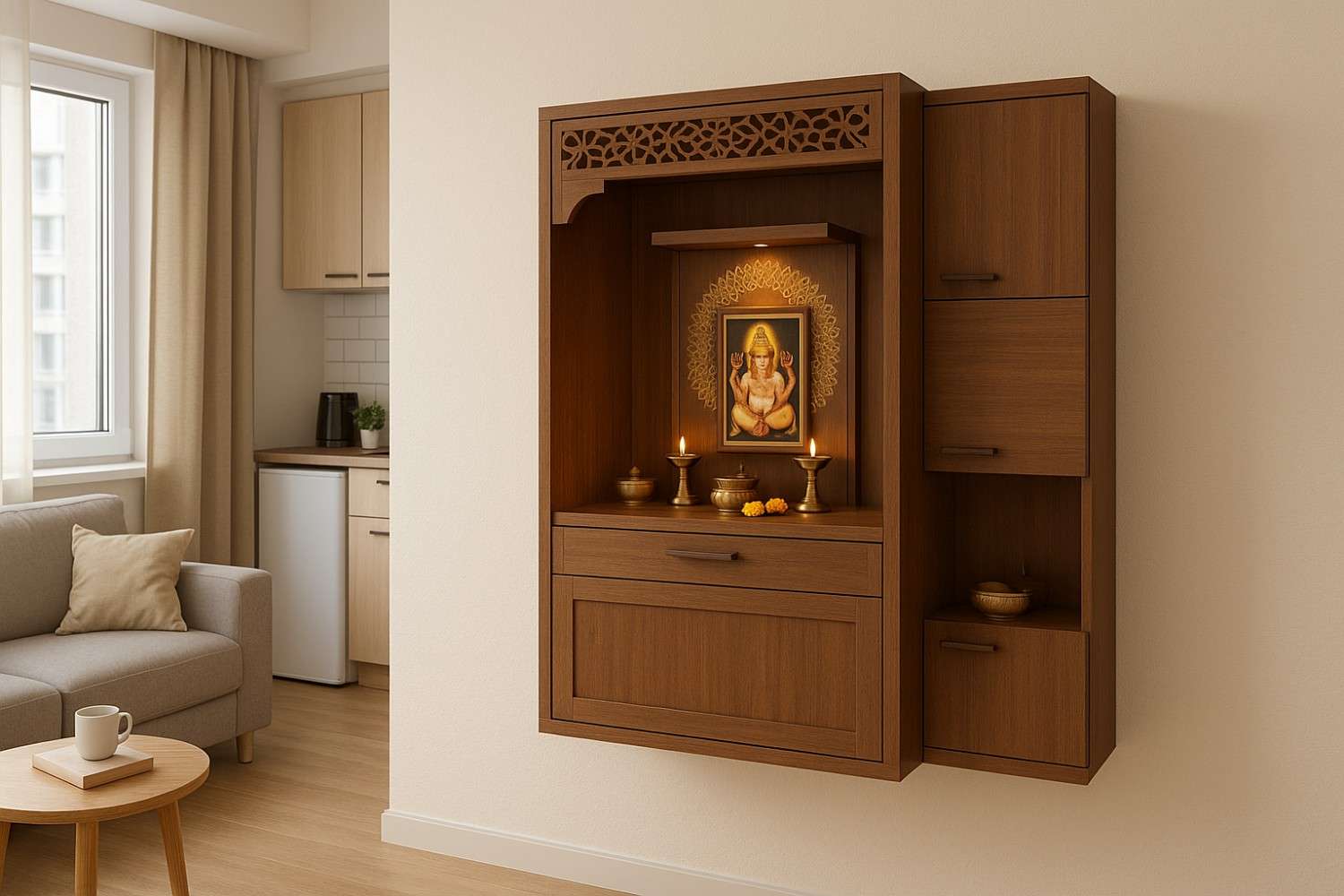
Small Pooja Room Design Solutions We’ve Perfected
Let’s be honest—most urban homes don’t have the luxury of dedicating an entire room to worship. We’ve become specialists in small pooja room design because that’s what 80% of our clients actually need.
We’ve discovered that vertical space is your best friend. One of our favorite solutions involves creating wall-mounted units that literally disappear when not in use. We designed a fold-down altar for a client in a 1BHK apartment that transforms from a sleek wall panel into a complete pooja setup in seconds.
Corner spaces work magic too. We’ve learned to use every inch effectively—incorporating storage for prayer books, diyas, and incense while maintaining that sacred feeling. Our clients are often surprised by how spacious a well-designed corner pooja feels.

The glass partition approach has become increasingly popular. We use frosted or etched glass to create distinct pooja spaces within living areas without making rooms feel cramped. It’s transparent enough to maintain openness while providing that essential sense of sanctity.
For more comprehensive Pooja Room Designs by Elegante Interiors, we’ve documented various space-saving solutions that have worked brilliantly for our clients.
Our Top Modern Pooja Room Ideas That Actually Work
After designing hundreds of pooja rooms, we’ve identified six approaches that consistently deliver stunning results:
The Minimalist Marvel
We’ve found that minimalist designs resonate deeply with young professionals. Clean lines, single deity idols, and neutral color palettes create incredibly serene environments. One client told us her morning prayers became more focused after we simplified her cluttered traditional setup.
The key is choosing quality over quantity. We typically recommend one beautiful deity statue, subtle LED lighting, and maybe two decorative elements maximum.
Wall-Mounted Wonders
These have become our signature for compact homes. We design them with concealed hinges, built-in lighting, and hidden storage. The best part? They free up floor space completely while looking absolutely elegant.
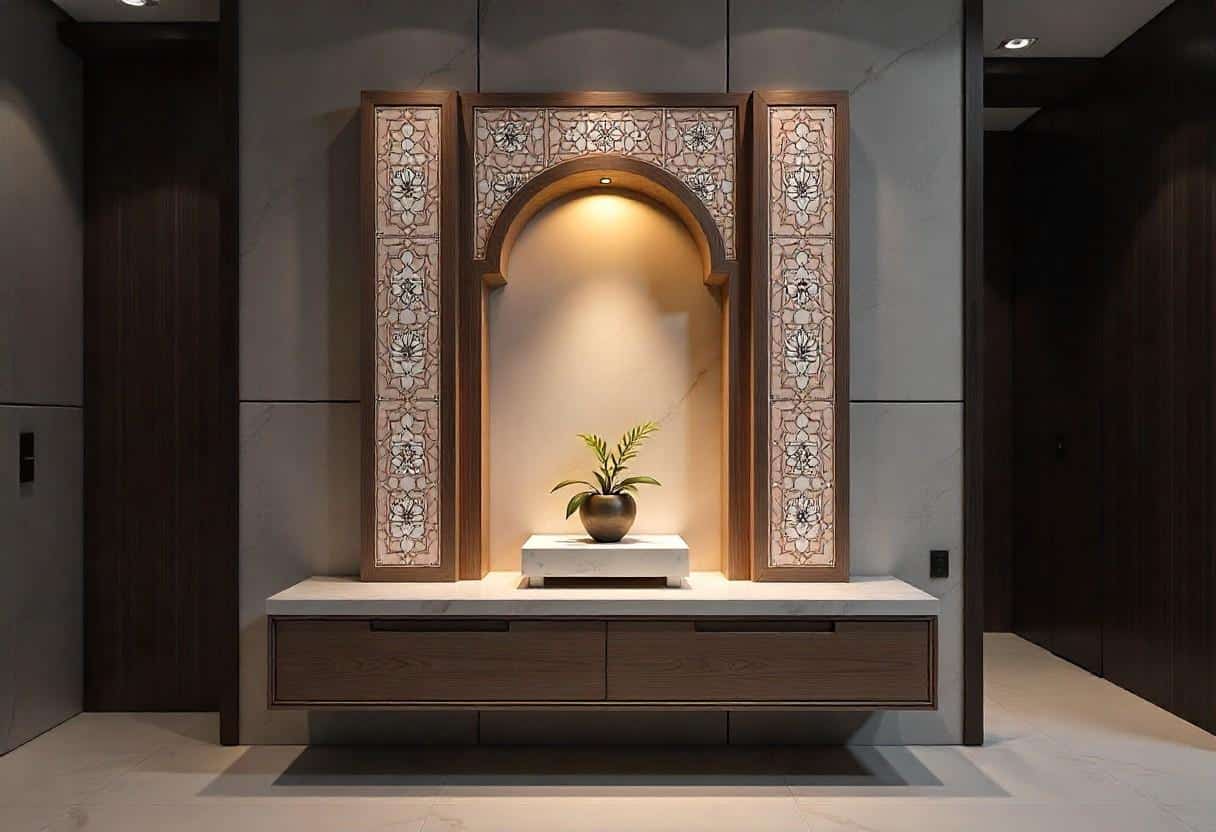
Glass-Enclosed Sanctuaries
We’ve perfected this style for open-plan homes. Using frameless glass creates visual separation without blocking light or making spaces feel smaller. We often incorporate etched patterns or stained glass for added privacy and beauty.
Multi-Functional Designs
These are game-changers for studio apartments. We’ve created pooja units that double as room dividers, study desks, or even entertainment units. The functionality doesn’t compromise the spiritual aspect—it enhances it by making the space more integrated into daily life.
Heritage-Modern Fusion
This style appeals to families wanting to honor tradition while embracing contemporary aesthetics. We combine intricate carvings with sleek materials like acrylic or brushed metal. The contrast is stunning and deeply meaningful.
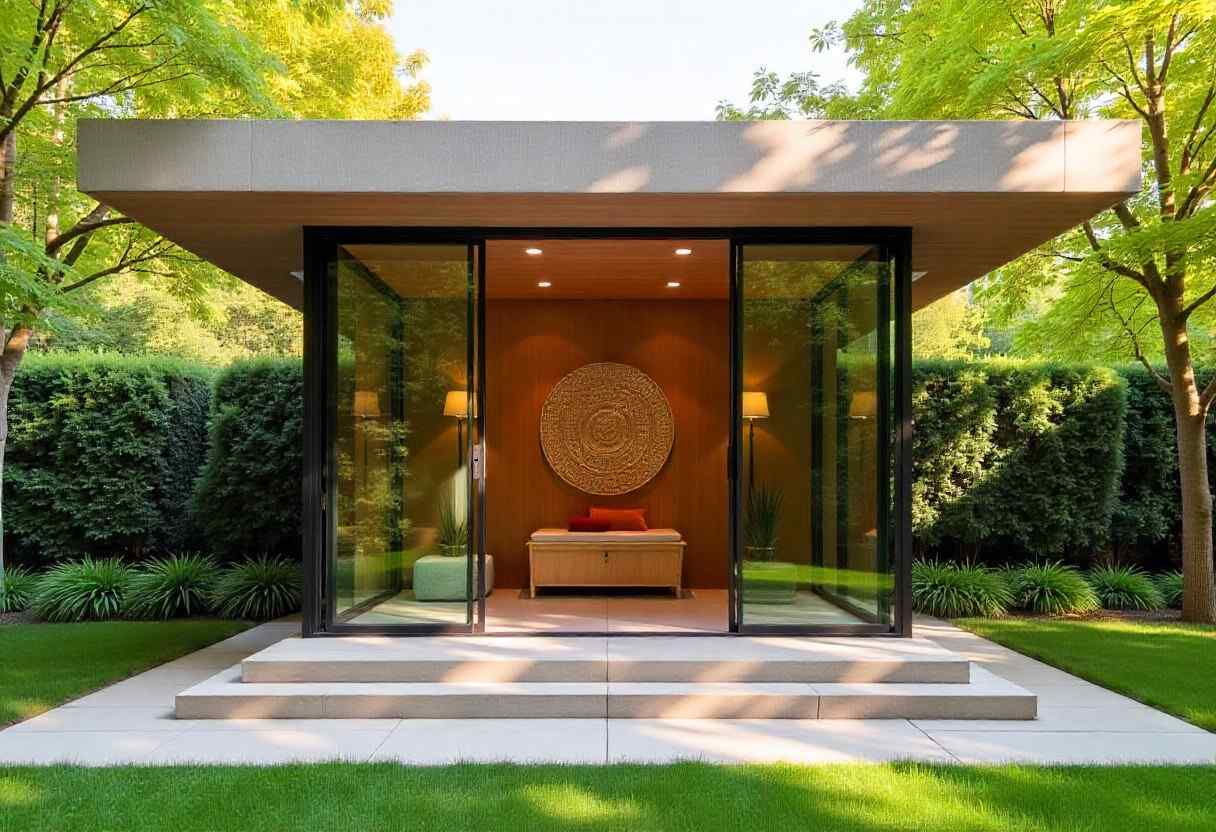
Smart Technology Integration
We’ve started incorporating smart features after client requests. Automated lighting that adjusts throughout the day, digital prayer bell systems, and climate-controlled storage for offerings. It sounds futuristic, but it genuinely enhances the worship experience.
Materials That Make All the Difference
We’ve experimented with countless materials over the years, and certain combinations consistently deliver exceptional results.
Marble remains our top choice for altars. We’ve worked with Makrana marble, Italian Carrara, and local varieties. Each has its character, but all age beautifully and maintain that timeless elegance.
Wood selection matters enormously. We typically recommend teak for its durability and rosewood for its rich grain patterns. Walnut has become popular recently for its contemporary appeal.

Metal accents elevate any design. We use brass for traditional touches, copper for warmth, and brushed steel for contemporary aesthetics. The key is restraint—too much metal overwhelms the space.
Glass and acrylic work beautifully in modern designs. They reflect light, create depth, and maintain that clean aesthetic urban families love.
Lighting Secrets We’ve Learned Over the Years
Lighting can make or break a pooja room design. We’ve learned this through some spectacular successes and a few early mistakes.
Warm LED lights are non-negotiable. We typically use 2700K-3000K temperature ranges to create that golden, divine glow. Harsh white lights completely destroy the spiritual ambiance.
Layered lighting works best. We combine ambient lighting for overall illumination, accent lights to highlight deity statues, and task lighting for reading prayers or handling ritual items.
Dimmable controls are essential. Morning prayers might need brighter light, while evening meditation benefits from softer illumination. We always install dimmer switches.
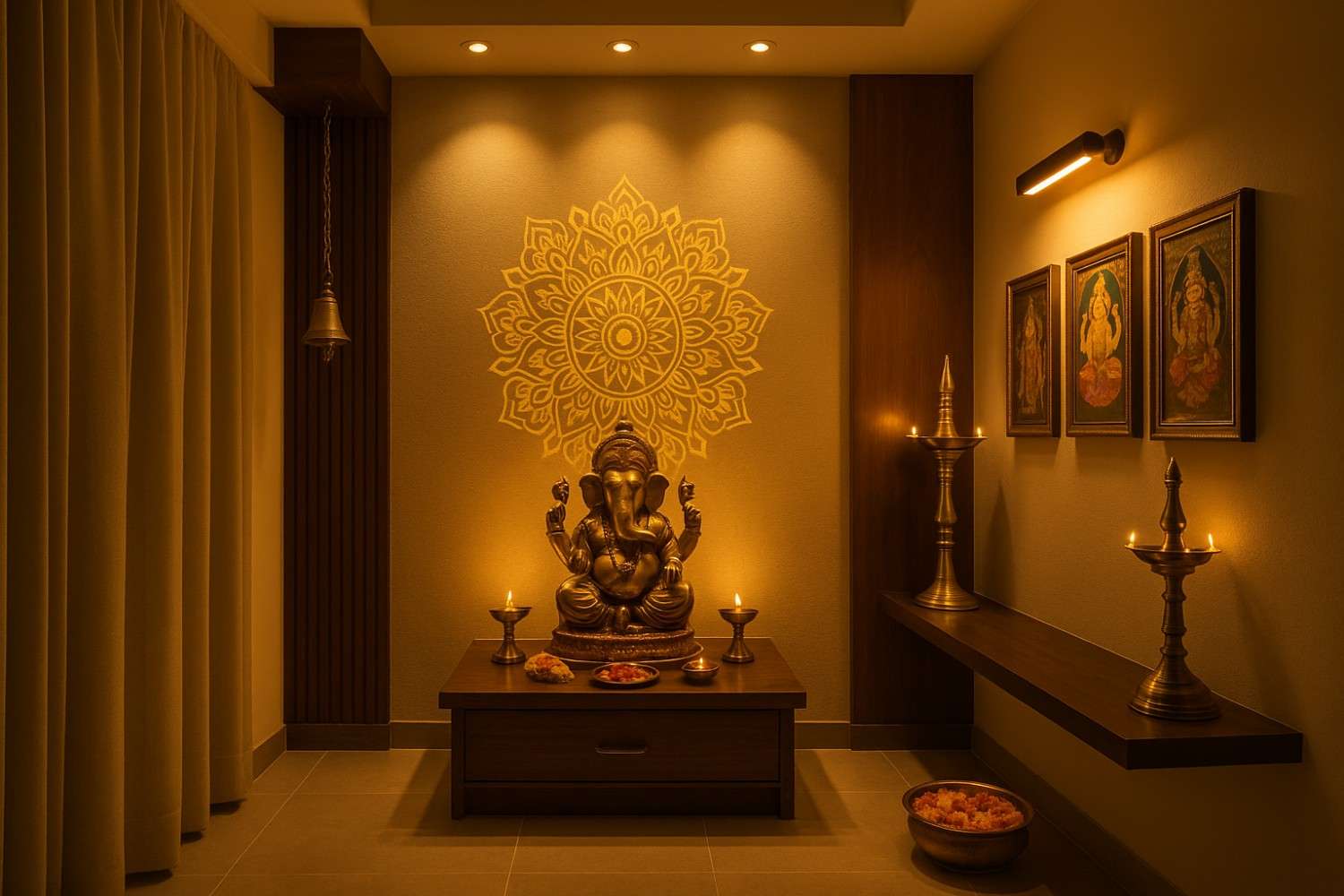
Vastu-Compliant Designs That Don’t Compromise Style
We’ve learned to seamlessly integrate Vastu principles into contemporary designs. Initially, we thought traditional guidelines would limit our creative freedom. We were completely wrong.
The northeast direction preference actually works perfectly with most modern floor plans. Natural light from this direction creates beautiful illumination throughout the day.
Elevated altar placement, recommended by Vastu, adds grandeur to modern designs. We use this principle to create dramatic focal points rather than seeing it as a restriction.
Keeping spaces clutter-free aligns perfectly with minimalist design principles. Vastu’s emphasis on cleanliness and organization enhances contemporary aesthetics rather than conflicting with them.
Why Choose Professional Interior Design
We’ve seen countless DIY attempts that looked promising in planning but fell short in execution. Professional design brings expertise you simply can’t replicate from YouTube tutorials.
Material selection requires deep knowledge. We understand which marbles work in specific climates, how different woods age, and which finishes maintain their appearance over years of daily use.
Spatial planning is crucial, especially for small pooja room design. We’ve developed techniques for maximizing functionality while maintaining proper proportions and visual appeal.
Technical aspects like electrical planning, ventilation, and structural modifications require professional expertise. We’ve prevented numerous costly mistakes by catching issues during planning phases.
Frequently Asked Questions About Pooja Room Design
Which direction should face my pooja room?
We always recommend northeast corners when possible. This direction receives beautiful natural light and aligns with traditional Vastu principles we’ve found enhance the spiritual atmosphere.
How do you design pooja rooms in really small apartments?
We’ve become experts at this challenge. Wall-mounted units, corner installations, and multi-functional designs allow us to create meaningful spiritual spaces in even studio apartments. Every square foot counts.
What materials work best for different budgets?
We offer solutions across all price points. Engineered marble provides luxury appearance at moderate costs, while solid wood veneers deliver premium aesthetics without solid wood pricing. We’re transparent about options.
Can pooja rooms integrate with modern living spaces?
Absolutely. We’ve designed dozens of pooja spaces within contemporary living areas using glass partitions, decorative screens, or artistic room dividers. The integration enhances both spaces.
How important is professional lighting design?
In our experience, lighting makes the biggest difference in creating proper ambiance. We’ve transformed ordinary spaces into extraordinary sanctuaries primarily through sophisticated lighting strategies.
Creating Your Dream Spiritual Sanctuary
Modern pooja room ideas continue evolving as urban living spaces change and family needs shift. We’ve learned that the most successful designs balance tradition with innovation, functionality with beauty, and personal preferences with timeless principles.
Whether you’re envisioning a grand prayer hall or need creative small pooja room design solutions, the key lies in understanding your space, lifestyle, and spiritual practices. We’ve found that involving the entire family in design discussions creates spaces everyone actually uses and cherishes.
Your pooja room should inspire daily spiritual practice while seamlessly integrating with your home’s overall aesthetic. It’s not just about following trends—it’s about creating a space that genuinely enhances your family’s spiritual journey.
Ready to transform your prayer space into something extraordinary? We’d love to discuss your vision and share how our expertise can bring your dream pooja room to life. Let’s create a sacred space that reflects both your devotion and your style.
📞 Contact us for a free consultation or visit eleganteinterior.com to explore our portfolio!

